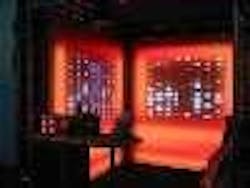The light behind the curtain: LED tile offers modular solution for backlighting
Although LEDs are an excellent light source for backlighting translucent materials as backdrops for exhibitions, stage productions and other entertainment events, it is necessary to ensure perfect colour mixing from the red, green and blue components and prevent shadows and other effects when the backlit material is placed too close to the source.
Schnick-Schnack-Systems GmbH, a company based in Cologne, Germany, has developed a product designed to provide uniform backlighting. The LED-Kachel (Kachel is the German word for tile) is a DMX controlled colour mixing system on a single PCB. The 10 x 10 cm version contains 9 RGB LEDs, while the 20 x 20 cm version has 16 cm devices; these are packaged modules containing red, green and blue chips, and are supplied by Japanese LED manufacturer Nichia.
"Many lighting designers asked for a very flexible LED product for backlighting any kind of translucent material," says Erhard Lehmann, Schnick-Schnack-Systems' CEO. "Backlighting with LEDs is a perfect solution which could not be done with any other lighting system before, at such a small distance."
A CPU that provides 16 million instructions per second enables the system to perform smooth fades and fast flashes and to operate flicker-free, even for TV and video cameras.
Other markets, such as architectural and retail, are expected to benefit from the Kachel as it can be mounted easily behind any surface, so every architect or designer can choose his own material.
Schnick-Schnack-Systems outsources the PCB manufacturing and component assembly for the Kachel, but carries out colour matching, programming and quality assurance in-house.
Lehmann also says that his company has a patent pending concerning direct exponential modulation, which overcomes the problem with visible brightness steps in the low intensity area using DMX. It takes into account the behaviour of the human eye and makes hardware a lot easier compared to pulse-width modulation.
